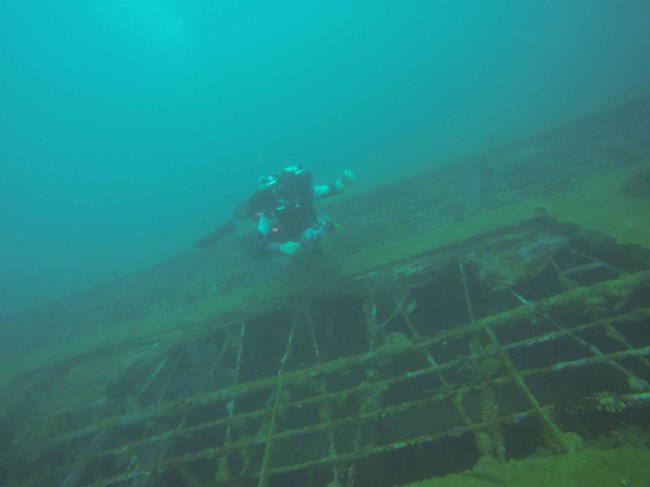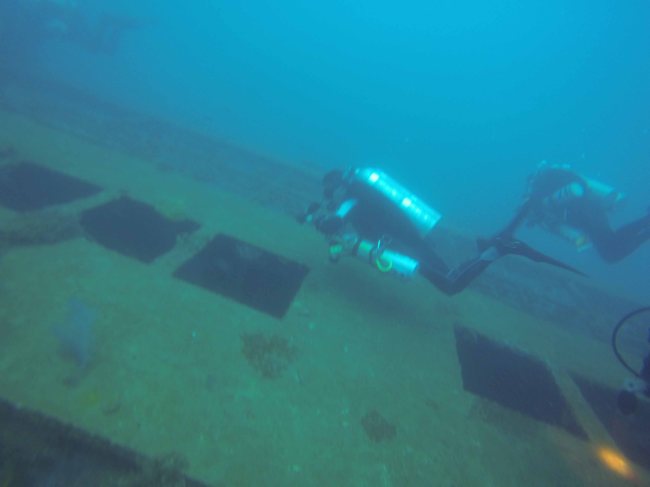Extended Range Diving – by Chris Greising
I was sleeping on a black sand beach in Hawaii while I hunted for my first job in the diving industry. I had flown out to the Big Island from the Florida Keys the day after I completed my training and had about $200 in my pocket, a small tent, and the determination to find work as a dive instructor. During one of my daily 20 mile hitchhiking commutes into Kona from Ho’okena beach I decided to stop into a small bookstore along the way. While wandering around the stacks and stacks of books I happened upon one that instantly caught my eye.
The book was called Shadow Divers and it seemed to have it all: exploration, adventure, mystery, history, and of course Scuba diving. It’s the story of a group of wreck divers that are tipped off to a possible wreck off the coast of New Jersey in some particularly dangerous diving conditions. After getting to the site and descending down they discover that the wreck is of a previously unknown World War II German U-Boat. After multiple dives to the wreck, there are no markings on the outside or clues found on the inside that can be used to identify this ill-fated submarine. The men attempt to track the history of the U-Boat on land and at 73 meters [240 feet] under the Atlantic Ocean at the submarine’s final resting place.
I instantly became fascinated by the type of diving they were doing. While recreational dive limits are 30 m or 100 feet extended range technical diving allows divers to go deeper for longer periods of time. Another area of technical dive training teaches how to enter, or penetrate, wrecks. It’s also a much more equipment intensive and physically and mentally challenging form of diving than recreational diving. So when I was offered the job here at Scotty’s and learned I could train in SSI’s Extended Range [XR] diving specialty, I jumped at the opportunity.
The course included me, Scotty’s diving manager Peter, married couple Philip and Silke, and our XR trainer Ray. The couple are both doctors from London. Philip works with the disabled, mostly veterans, and Silke is a pediatrician. They are a very nice and friendly couple who love diving and beer. Originally they planned to just come to the Shangri La and do some recreational diving but when Ray responded to one of their emails, Philip saw Ray’s XR Instructor certification and, in Silke’s words, his eyes lit up. Philip is a dive master and Silke a rescue diver so they both came into the training with a good amount of experience under their dive belts. This is a necessity when one begins to think about taking a technical dive training course.
Extended Range dive course is challenging and not something recommended for those without that experience and confidence in the water. The equipment is heavy, the dives are long and complicated, it’s physically demanding, and there’s a lot of new material to learn. You have to rely on your skills, your training and your problem solving abilities in order to have a successful XR dive. Even something as simple as deploying a surface marker buoy on a reel gets more complicated when you have to worry about run times, switching bottles, and maintaining your buoyancy and trim all at the same time.
But don’t let all that scare you off. Extended Range diving is completely worth it to anyone who has the desire and experience. There’s really nothing else like it.
Our first dive as certified XR divers was to the Liloan Wreck. The wreck sits on its side at about 50 meters with the top at about 35 meters. On the day that we went we were blessed with some fantastic visibility for the site. I had heard that on average it might be around five meters but luckily we had around 15 meters of visability for our dive. The wreck is about 30 meters long so we could see about half way down the ship from either end.
We came down the ascent/descent line and, unlike recreational diving where it is recommended that you descend fins first, we laid out flat on our stomachs with our knees bent and arms out, trying to give our best sky diving impersonation. From this position, watching the wreck as it slowly begins to emerge and take shape as we descended upon it was truly an incredible sight. Would be brilliant if white soft corals cover the wreck but at that depth everything has this dull green tint, it really is another world down there. We made our way around the wreck, reaching 45 meters in depth before coming up along the propellers to the side [top] of the ship. From there you can see into the ship’s interior but we never actually penetrated the wreck. After our 23 minutes were up we made our long, slow ascent back to the surface.
Philip, Silke and Ray made another dive this morning to Marigondon Caves. When they came back they told me they were able to see just how much of a difference being XR trained made. There was another dive operation at the site and as they got to the opening of the cave, the other non-XR divers peaked into the cave and had to come right back up since the opening sits at around 35 meters. Philip, Silke, and Ray, on the other hand, were able to actually enter the cave and explore around before they had to make their accent to the surface. I think that story perfectly sums up what being XR trained adds compared with recreational diving.
As a side note, I want to add that Silke really did have four cylinders on, two on her back and two stage bottles on her side. You’re welcome Silke, enjoy those well deserved beers, and it was a real pleasure diving with both you and Philip this past week!






